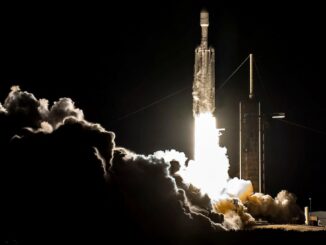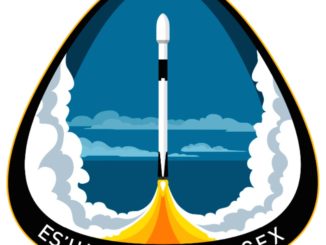EDITOR’S NOTE: United Launch Alliance ground crews raised the Atlas 5 rocket’s first stage inside the Vertical Integration Facility at Cape Canaveral’s Complex 41 launch pad Thursday, May 28, to begin stacking of the launch vehicle for the Perseverance rover mission.

Two key pieces of hardware needed for NASA’s next Mars rover — an Atlas rocket booster and sterile components of the rover’s sample collection system — recently arrived at Cape Canaveral ahead of the mission’s scheduled launch July 17.
The first stage of United Launch Alliance’s Atlas 5 rocket arrived at Cape Canaveral Air Force Station’s Skid Strip runway May 18 aboard a Ukrainian-built Antonov An-124 transport plane. The cargo aircraft carried the 107-f0ot-long (32-meter) Atlas first stage from Huntsville, Alabama, near ULA’s rocket factory in Decatur.
After unloading the booster from the cargo jet, ULA moved the rocket into the Atlas Spaceflight Operations Center for post-shipment checks.
ULA typically delivers rocket hardware launch sites using the company’s ocean-going vessel named “RocketShip.” But the vessel recently ferried there Delta 4 rocket cores to Vandenberg Air Force Base in California, and was not available for the Atlas 5 shipment to Florida.
Rocket and rover preparations for the July launch are continuing with safeguards to mitigate impacts from the coronavirus pandemic.
Omar Baez, NASA’s launch director for the Perseverance mission, said the rocket’s arrival at Cape Canaveral and the successful launch of the previous Atlas 5 flight May 17 “should set us up with plenty of time for hitting the beginning of the (rover) launch window July 17.”
“Things are progressing as well as they can,” Baez said.
Liftoff is scheduled at 9:10 a.m. EDT (1310 GMT) on July 17, within a broader window extending from 9:00-10:40 a.m. EDT (1300-1440 GMT), according to Baez.
“We’re really looking forward to this one,” he said. “Things evolve from day-to-day. We learn from every mission as far as things that we have to do to protect ourselves and to prevent the team from getting sick.
“We’re definitely are encouraging people, unless they have a significant primary role, not to travel for the testing or the launch,” Baez said. “That work is progressing as best we can. Obviously, there’s a lot of teleworking, but when we do have to have the hands-on work, we try to do it in as safe of a manner as possible.”
Hardware for the Perseverance rover landed at the Kennedy Space Center’s Launch and Landing Facility on May 11 on a NASA C-130 transport plane. The delivery included the mission’s sample tubes, cigar-sized metal cylinders that will store rock samples collected by the Perseverance rover for retrieval and return to Earth by subsequent robotic missions.
The two hardware arrivals signaled the start of a new phase of launch preparations for the Perseverance rover, the centerpiece of NASA’s $2.5 billion Mars 2020 mission.
The 43 sampling tubes are part of the rover’s sample handling system, consisting of a robotic arm, motors, seals and a rotating array of nine drill bits for abrading, regolith collection, and coring of Martian rocks. The specimens drilled from rocks will be stored into the metallic tubes, where samples will be hermetically sealed to await arrival of a follow-on robotic mission in the late 2020s, which will return the material to Earth for analysis.

The Perseverance rover is inside the Payload Hazardous Servicing Facility at Kennedy, where ground teams are putting the final touches on the spacecraft before its closed up inside the payload fairing of its Atlas 5 launcher.
With the final pieces of the sampling system now at Kennedy, NASA teams planned to finish installing the mission’s heat shield. Other tasks planned in the next few weeks include fueling of the mission’s cruise stage, which will shepherd the rover during the seven-month journey from Earth to Mars.
The rover — enclosed inside its atmospheric entry capsule — will then be mated with the cruise stage and attached to the Atlas 5’s payload attachment fixture. The entire spacecraft will next be encapsulated inside the Atlas 5’s Swiss-made payload fairing, then transferred to ULA’s Vertical Integration Facility for integration with the launch vehicle.
Stacking of the Atlas 5 rocket — tail number AV-088 — is scheduled to get underway May 28 with the hoisting of the first stage vertical on top of the Atlas mobile launch platform inside the VIF, according to Omar Baez, NASA’s launch director for the Perseverance rover mission.
ULA ground crews transferred the mobile launch platform back inside the VIF from Cape Canaveral’s Complex 41 launch pad last week following liftoff of the previous Atlas 5 flight May 17.
The Atlas 5 for the Perseverance rover mission will fly in the “541” configuration with four strap-on solid rocket boosters and a 17.7-foot-diameter (5.4-meter) diameter payload fairing.
ULA will install the Atlas 5’s four solid-fueled boosters after raising the first stage inside the rocket’s vertical hangar.
The Atlas 5’s Centaur upper stage, which will propel the rover on an escape trajectory away from Earth, will be stacked on top of the rocket around June 4, Baez said.

ULA will roll the Atlas 5 rocket out to pad 41 on June 17 for a fueling test. ULA performs such fueling demonstrations before launches with limited planetary launch windows to ensure teams can detect and resolve any problems one the rocket before launch day.
The Atlas 5 will return to the VIF after the tanking test.
“After we’re done with that, we’ll mate the rover spacecraft to the Atlas-Centaur on June 22, do a test between it and the rocket, and that’ll set us up pretty much for our final reviews, installation of the RTG, doing a dress rehearsal, and getting our launch readiness review out of the way,” Baez said in an interview with Spaceflight Now.
The Multi-Mission Radioisotope Thermoelectric Generator, or MMRTG, is the rover’s nuclear power source. The device converts heat from the radioactive decay of plutonium into electricity. Provided by the U.S. Department of Energy, the power generator is one of the final items installed on the rover in the final weeks before launch.
The Atlas 5 rocket is the only launch vehicle currently certified by NASA to carry nuclear-powered payloads into space.
The rocket assigned to the Perseverance rover launch has no significant modifications from ULA’s standard Atlas 5 vehicle, Baez said.
But there’s one change to the pyrotechnic system that would be activated to destroy the Atlas 5 if it deviates from its planned course and threatens populated areas. Such an event is highly unlikely, and the Atlas 5 has successfully reached orbit on all 84 of its missions to date.
“If you did have some kind of accident, that’s to prevent the MMRTG from being a danger to the public,” Baez said. “So we try to be very precise in destroying, for example the Centaur (upper stage), in a way that the MMRTG is not in harms way, where it could harm the public. Thats about the only difference between this and a non-nuclear mission.”
Baez said the same type of ordnance system was used on the Atlas 5 rocket that launched the Curiosity Mars rover in 2011. The Perseverance rover is similar in design to Curiosity, but carries a different set of scientific instruments.
The Perseverance rover’s launch window extends from July 17 through Aug. 11. NASA and ULA recently assessed the performance of the Atlas 5 rocket and the final mass of the spacecraft, engineers determined they could add six days to the launch period.
Launch opportunities to Mars only come about once every 26 months, when the positions of the planets make a direct journey possible.
Email the author.
Follow Stephen Clark on Twitter: @StephenClark1.



